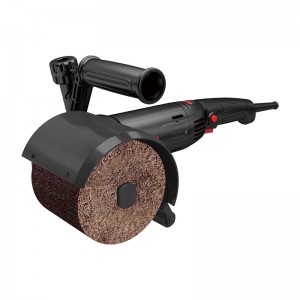In the process of stainless steel wire drawing, surface scratches are a common quality problem, which not only affects the appearance of the product, but also may reduce its performance. Therefore, it is important to take effective measures to avoid surface scratches. The following starting from the design points of polishing roller and damping guide wheel, discuss how to avoid surface scratches in the process of stainless steel wire drawing.
First, polishing roller design points
Surface roughness control
The surface roughness of polishing roller directly affects the surface quality of stainless steel wire. According to the relevant technical requirements, the surface roughness of the polishing roller should reach Ra < 0.2um, Rz < 1.0um. This ensures a more even contact between the roller and the stainless steel wire during the drawing process, reducing scratches caused by rough surfaces.
In order to meet the above roughness requirements, the polishing roller needs to be finely polished and polished during the manufacturing process to ensure that its surface is smooth and flawless.
Material selection
The material of the polishing roller should have high hardness and good wear resistance to reduce the scratches caused by the wear of the roller. Commonly used materials include cemented carbide or specially treated steel.
For example, the use of cemented carbide material polishing roller, its high hardness, can effectively resist the friction of stainless steel wire in the drawing process, reduce the generation of scratches.
Dimensions and installation accuracy
The length of the polishing roller should be greater than the maximum distance between the two sets of clamping tables. This ensures that the stainless steel wire is always in good contact with the roller during the drawing process, avoiding scratches caused by poor contact.
When installing, it is necessary to ensure that the polishing roller is parallel to the stainless steel wire being drawn, and the parallelism of the relative roller is detected through the displacement sensor, and the handles on both sides are adjusted to make the polishing machine parallel to the polished roller. In addition, it is necessary to adjust the contact amount between the polishing roller and the polished roller through the screw mechanism to achieve accurate polishing.
Second, shock absorber guide wheel design points
Damping function
The main function of the damping guide wheel is to reduce the vibration of the stainless steel wire in the drawing process. By installing a damping device in the guide wheel, such as a spring or rubber pad, the vibration generated during the drawing process can be effectively absorbed.
For example, the design of a tightened spring can increase the clamping strength of the guide wheel against the stainless steel wire, while reducing the impact of vibration on the surface.
Surface treatment
The surface of the damping guide wheel should be specially treated to reduce friction with the stainless steel wire. Chrome plating or coating technology can be used to improve the wear resistance and scratch resistance of the guide wheel.
For example, chrome plating on the surface of the guide wheel can significantly improve its hardness and wear resistance, reducing scratches caused by friction.
Installation and commissioning
The installation position and Angle of the shock absorber guide wheel need to be precisely adjusted to ensure even contact with the stainless steel wire. During the installation process, it should be ensured that the contact point between the guide wheel and the stainless steel wire is in the best position to avoid scratches caused by poor contact.
By adjusting the installation Angle and position of the guide wheel, it can be ensured that the stainless steel wire always maintains a stable motion state during the wire drawing process.
Raw material pretreatment
Before drawing, the raw material surface of stainless steel wire needs to be pre-treated to remove impurities such as oxide and oil. This reduces scratches caused by surface defects in raw materials.
For example, the chemical degreaser is used to remove the rolling oil film, the impregnation temperature should be controlled at 40-50℃, and the treatment time should not be less than 15 minutes.
Equipment maintenance
Maintain drawing equipment regularly to ensure it is in good working condition. Check the wear of polishing roller and shock absorber guide wheel, and replace the badly worn parts in time.
For example, the surface roughness of the polishing roller is checked regularly to ensure that it meets the technical requirements.
Operating specification
Operators should strictly follow the operating procedures for wire drawing operations to avoid scratches caused by improper operation. During the operation, the drawing speed and pressure should be controlled to ensure the stable movement of the stainless steel wire.
For example, reasonable control of the cutting speed and pressure of the press wheel to avoid scratches caused by too fast speed or too much pressure.
Through the above design points and precautions, the surface scratches in the process of stainless steel wire drawing can be effectively avoided, and the quality and appearance of the product can be improved. I hope these suggestions can help you reduce scratch problems and improve product quality in actual production.
Post time: Apr-10-2025

